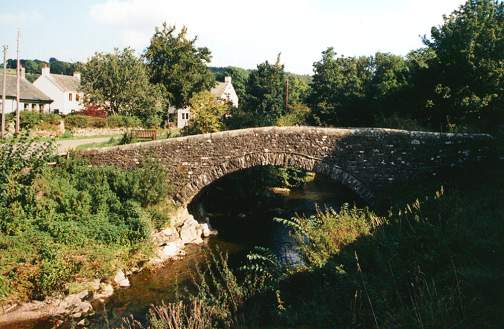All Photos Copyright © D.Hickson 2001. All Rights Reserved
" The horn of the hunter's now silent ".. is the name of another song which laments John Peels death.
The well worn path which leads to his gravestone suggests that he may be dead, but he certainly
is not forgotten. Hunting still holds a strong following in the northern fells and the direct
descendants of John Peel's foxhounds now form the Blencathra pack which still meets in Caldbeck
village several times each year.

In the late 18th century there were 54 miners, 20 weavers, 11 blacksmiths, 13 shoemakers and 4 cloggers
living in Caldbeck, which gives an idea of the commercial importance of the village in former times.
Even now one clogmaker still carries out his traditional craft. Some of the industrial buildings
such as the Old Smithy and Priests Mill now house craft shops and other tourist attractions.

Next to the small bridge behind the church is St Mungo's Well, named using the nickname of St. Kentigern who came to this area to preach in the 6th Century. If you carry along the road heading down river you pass by Priests Mill which is now a tourist centre and then you arrive at a footpath which leads to the "meeting of the waters " where the River Caldew and Cald Beck join. This is a beautiful area in magnificent countryside.

Sheep personify the Northern Fells much to the annoyance of the owners of the many beautiful gardens in Caldbeck and other fellside villages. If it is green the sheep will eat it and meer fences will not deter them from reaching lush garden plants.

After you have sat by the village pond feeding the ducks (and sheep!) there is a lovely walk starting from near the pond which leads through the Howk, a limestone gorge, with waterfalls and also the remains of the bobbin mill. This mill was built in 1857 and had a water wheel of 42ft diameter which at that time was claimed to be the largest in the land. Wooden bobbins were produced for the cotton industry in Lancashire and elsewhere. Eventually the mill closed due to the decline in the textile industry in the 1920s and the wheel was dismantled in 1940 so that it's 30 tons or so of metal could be used to help the war effort. The bobbin mill is still in quite a good state of repair and possibly it may soon be renovated.
.
The Cald Beck, Caldbeck

.
Carrock Fell
From Caldbeck you can drive out of the village past the church through Hesket Newmarket and on towards Mungrisedale village. Carrock Fell is the first of the higher fells that you approach and is characterised by a large expanse of huge broken rocks as shown in the following photo. Carrock Fell has been an important mining area for centuries and at the base of the fell there are still signs of the Elizabethan silver mine.

A track leads from near the approprately named Stone Ends Farm diagonally up to the left onto a steep grassy gulley and then towards the summit of Carrock Fell. At the summit the remains of an iron age fort are still visible. There are signs of an outer enclosure encircling an area of 5 acres, within which are the remains of inner smaller stone enclosures. However the site is now in such a state of ruin that an exceptional imagination is necessary to visualise the site's former glory.

CLICK. CONTINUE.....OR..... LAKE DISTRICT INDEX
.
.
.
.
Lakes counter








